Butterflies - Healthy Life Essex
Home » Articles » Outdoor Life » Wildlife » Insects and Invertebrates » Butterflies
Butterflies in Essex
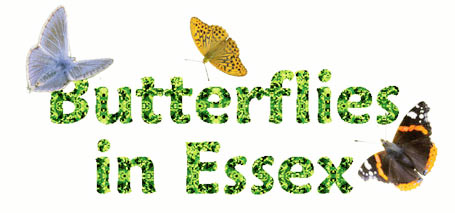
Butterflies are the most popular of all insects, their bright colours enliven our gardens in summer and an increasing number of people go to great efforts to attract them. I have yet to meet anyone who was disgusted at the sight of a butterfly, yet unfortunately, this is a frequent response some people have to many other insects, even though they are just as colourful. I did see someone run screaming from a tropical butterfly house once, but thankfully, butterfly-haters are very rare.
A Passion for butterflies
It was butterflies that first aroused my interest in insects. This interest really took off when, barely into my teens, my parents bought me the basic equipment for collecting – a net and some setting boards (these days I prefer to collect with a camera, but many insects, even moths, still require collecting in order to correctly identify them).
I spent much of my spare time scouring the countryside for choice butterfly sites on a bicycle. This was my open air class room where I learnt so much, not just about butterflies, but also about plants, habitats, and the multitudes of other insects that make up the natural world. It was this love and curiosity about the natural world that ultimately changed the course of my life as I later studied insects at university and became a professional entomologist.
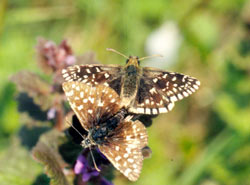
A lot has changed since my bicycle trips in the 1960s. I often wonder if any boy now would even be allowed to cycle off to God knows where, without even so much as a mobile phone. In those days we used the term ‘conservation’ when talking about tigers, giant pandas or red kites in Wales. There were few people concerned about butterflies or other insects. Yet even then, the warning signs were there and a number of species were declining. On my cycle trips to the Wyre Forest in Worcestershire (I lived in Birmingham), I could find Pearl-bordered Fritillaries, Grizzled and Dingy Skippers in abundance. Silver-washed Fritillaries were common and even the High-brown Fritillary could be found along certain rides well into the 1970s.
The decline in butterfly numbers did not go un-noticed, and in 1968, the British Butterfly Conservation Society was founded. This society is now in the forefront of efforts to conserve butterflies and in its 40th year has 13,000 members, 33 nature reserves, 53 staff and a UK network of 31 active volunteer Branches.

Essex – a butterfly paradise?
Believe it or not, Essex was once a wonderful county for butterflies. The famous expert and writer on butterflies, F. W. Frohawk, actually moved here (to Thundersley) in the early 20th Century, mainly because there were so many types of butterfly to be found in the vicinity. So why have butterflies become scarcer? Primarily, this has been due to changes in their habitat. With gathering pace, the countryside has seen drastic changes over the last hundred, or even fifty years.
A Lost Landscape
Most Essex farms were once small, mixed, organic farms which grew both arable crops and kept livestock. Small fields separated by hedgerows were the order of the day, not the vast prairies of today.

In the first half of the 20th Century there would have been plenty of permanent pastures and hay meadows, some of them un-ploughed for centuries. These have all now virtually disappeared. Industrially produced fertilizers, herbicides and pesticides, as well as modern machinery, have enabled crops to be grown year after year on the same ground and by fewer people. Where hay was once the mainstay of animal feed, it has now largely been replaced by silage and industrially produced pellets. In the last century, large areas of marginal land on marshy or poor soil were also brought into cultivation assisted by grants and other incentives.
Dutch Elm Disease and the consequent removal of dead trees was a convenient excuse for a last blitz on hedgerows in the 1970s, already suffering from the onslaught of field enlargement and stubble-burning. Today, there is often greater bio-diversity in our towns and parks than in the surrounding countryside, and some of the richest insect sites are on industrial wasteland.
By the 1950s, the management or coppicing of woodlands had virtually ceased as the demand for wood and timber declined. Some were clear-felled and replaced by conifer plantations, but gradually our woods and forests became too dark and shaded for many butterflies. The loss of many woodland butterflies is, of course, only the tip of an iceberg, as many other insects have been adversely affected resulting in the falling numbers of farmland and woodland birds.
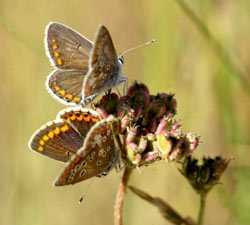
Butterflies Today
Despite all this doom and gloom, some butterflies have actually increased their numbers during the last 50 years. The Speckled Wood, now a common butterfly of woodland rides and hedgerows, has been expanding its range and increased considerably since the 1950s. It actually prefers the shady conditions found in many of our woods. By 1900, this butterfly had virtually vanished from Essex, though it survived up until the 1890s in Epping Forest. The Brown Argus, too, is commoner and more widely distributed than it used to be, as are three migrants from southern Europe, the Red Admiral, Painted Lady and Clouded Yellow. Indeed, increasing numbers of Red Admirals now spend the winter here. Warmer temperatures appear to be benefiting these species and even some of our native butterflies are currently spreading northwards. However, several species have been lost completely from Essex.

Butterflies of Grasslands
Today, the best areas for butterflies are in the those parts of the countryside which have escaped intensive farming. These are the grazing marshes, sea walls, and protected areas such as Country Parks and nature reserves. Once abundant grassland butterflies such as Essex, Small and Large Skippers, Meadow Browns, Gatekeepers and Common Blues are still fairly common but not in the numbers that they formerly were. The pretty little Grizzled Skipper, once widespread, is now found almost exclusively on the old meadows near Basildon and the Wall gets rarer every year. However, a few species such as the Marbled White and Ringlet have actually increased recently.
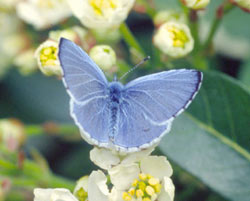
Butterflies in Urban Areas
Urban gardens, parks, railway embankments, allotments and waste ground also offer a welcome sanctuary to our beleaguered butterflies. They are commonly frequented by Large, Small and Green-veined Whites, Red Admirals, Peacocks and Holly Blues as well as the occasional Comma. The Small Tortoiseshell, once a familiar visitor to garden buddleias has unfortunately virtually gone from Essex gardens in recent years. The reason for this may be the recent invasion of a parasitic fly which kills the caterpillars, but this shows how important it is to research all aspects of a butterfly’s life cycle and ecology.
Some of the richest butterfly habitats are actually brown-field sites, such as the amazing western tip of Canvey, the site of an abandoned oil refinery and one of the best sites for insects in the whole country. Unfortunately, these are also the most threatened by development.
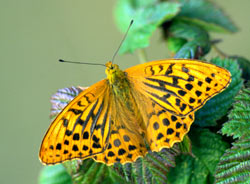
Woodland Butterflies
Woodland butterflies are also much scarcer than formerly and several no longer occur in Essex. Gone are all the Fritillaries, though some such as the Heath and Silver-washed Fritillaries have recently been successfully re-introduced after extensive coppicing. The magnificent Purple Emperor and Wood White had gone from Epping Forest even before the 20th Century began and the Duke of Burgundy was not seen in Hockley Woods after the 1920s.
It was the end of woodland management that put paid to these butterflies which loved sunny rides and clearings. Luckily, there is now an awareness of how the neglect of woods leads to a loss in biodiversity, and increasingly, councils and wildlife organisations are restarting coppicing just for wildlife. This may at last be reaping benefits. For instance, White Admirals were again seen in Belfairs Wood during 2007 and 2008 after an absence of 50 years.
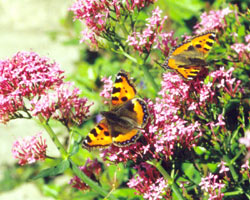
Butterfly Conservation
We have about 57 species of butterfly in the British Isles compared with 440 species in the rest of Europe. Several British butterflies are now very rare, surviving only through the careful management of their habitat. Most of us would agree that it would be a tragedy to lose them. Luckily, there are a number of organisation you can join that are working to conserve them, including Butterfly Conservation, Buglife, the Wildlife Trusts, the National Trust and Natural England.
Currently, Butterfly Conservation has 31 local branches and 28 specialist staff involved in monitoring butterfly numbers and conservation work throughout the United kingdom. They rely mostly on volunteer help and there is a local branch which covers Cambridgeshire and Essex.
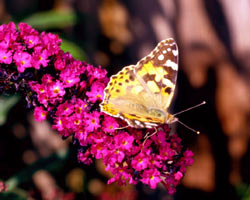
Butterflies in Your Garden
Another way of helping butterflies is to create a butterfly-friendly garden. Butterflies mainly use small gardens as fuelling stations. Certain flowers are more attractive to butterflies than others, so its all about choosing the right ones. Also, butterflies themselves have preferences which often boils down to simple anatomy such as the length of their tongue (proboscis).
In my experience, some of the best garden plants to grow are aubretia, bugle and golden alyssum (useful in early spring), buddleia, any of the thistles, including globe thistles and eryngiums, lavender, red valerian, cosmos, sedums (especially Sedum spectabile), thrift, verbenas, wallflowers, marjoram, mints, thyme and ivy (for the autumn flowers).

In addition there are a number of wild flowers that attract butterflies, such as knapweeds, viper’s bugloss, hemp agrimony, fleabane, ragwort, ox-eye daisy, chicory, clovers and vetches, scabious and teasel. In the larger garden, bramble (or blackberry) flowers will attract some butterflies which are less common in gardens, such as the Gatekeeper and skippers.
A few butterflies will even stay to breed in gardens. Holly Blues will lay their eggs on the flower buds of ivy, holly and occasionally other shrubs such as dogwood, spindle and pyracantha. Green-veined Whites and Orange tips lay on garlic mustard (an annual weed), cuckoo flower, dame’s violet and honesty.
If you grow nasturtiums you may attract Large and Small Whites as well as Green-veined Whites to breed. Some of our most colourful garden butterflies; Red Admirals, Peacocks, Commas and Small Tortoiseshells lay their eggs on nettle leaves. However, you will need plenty of space as they prefer to lay amongst largish nettle beds which are usually sheltered and in full sun.
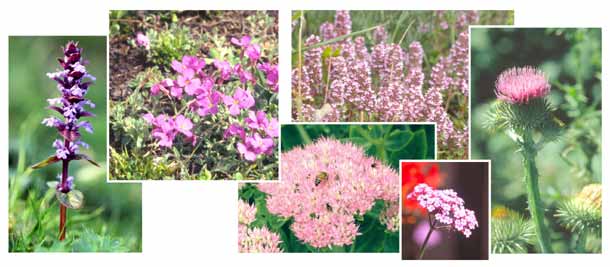
Roger Payne
